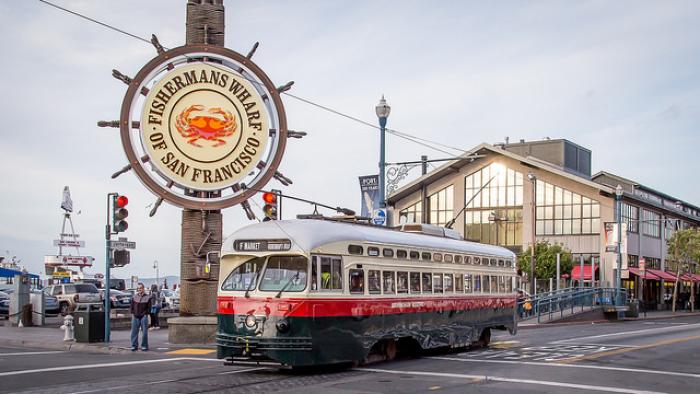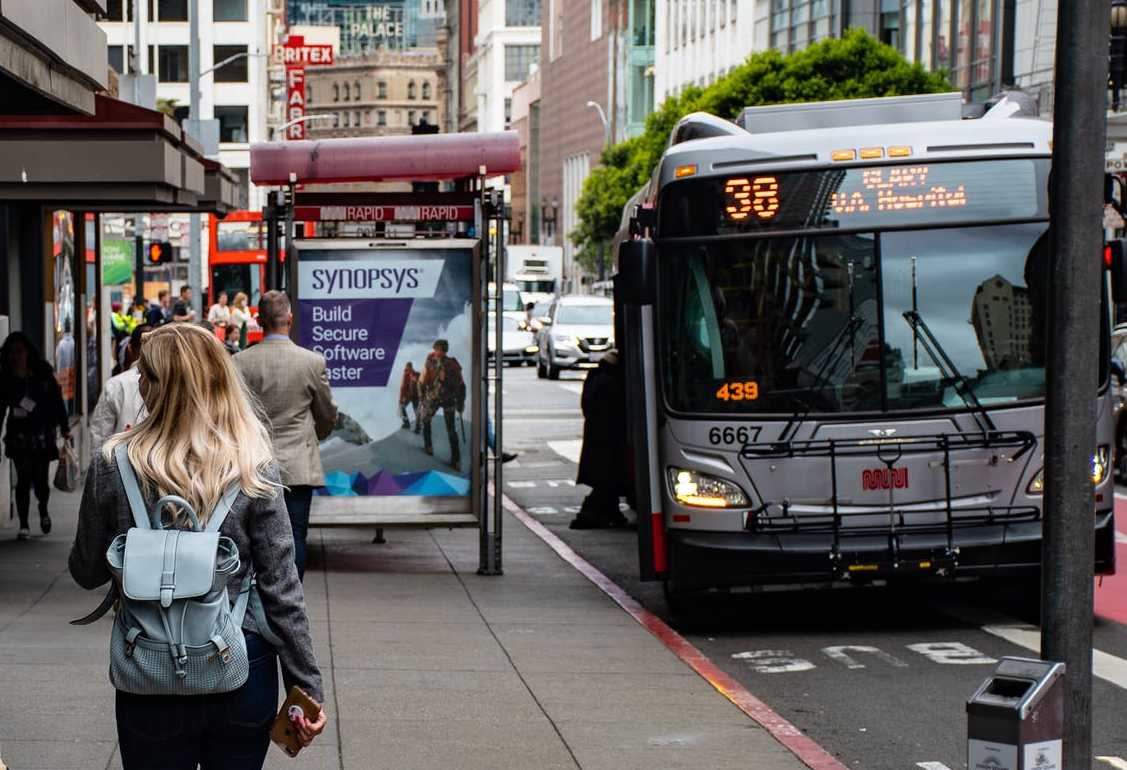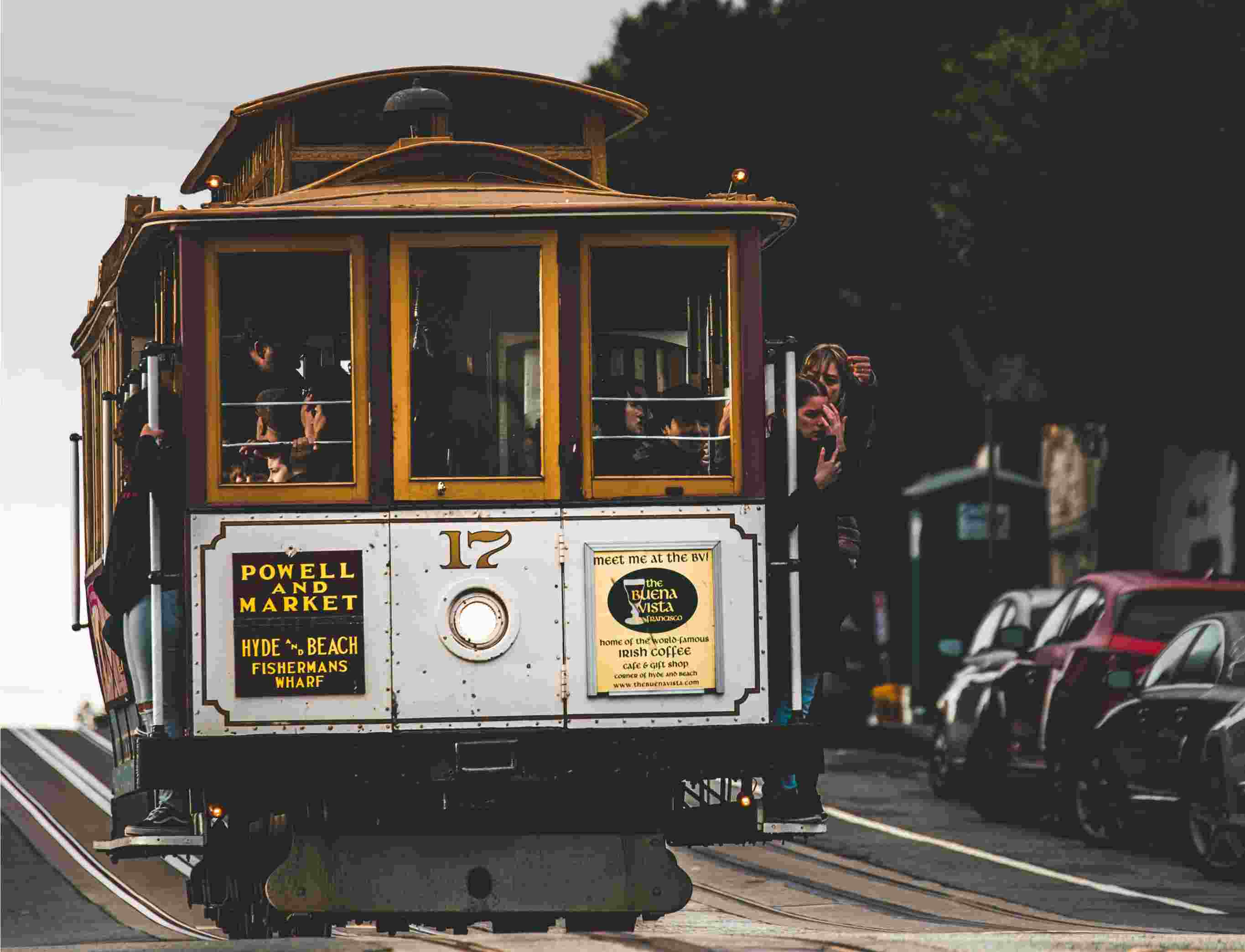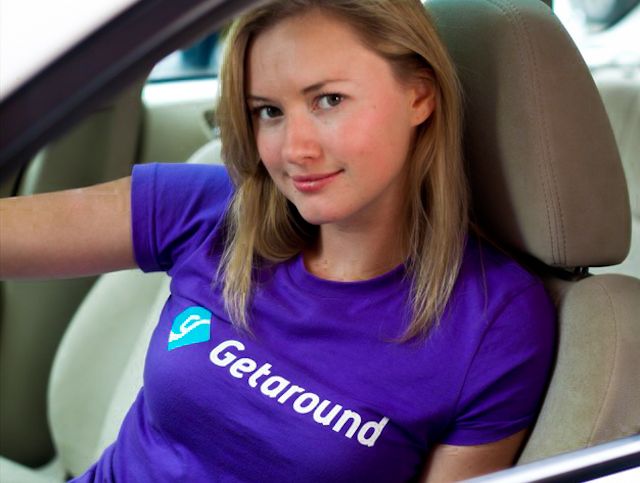Getting Around San Francisco On The Cheap: A Guide for Hostelers

Getting around San Francisco might seem daunting when you first arrive.
You will want to see as many of the great sights as you can but without spending most of your budget.
You could drive, but that comes with many issues (more on that headache later).
Realistically — as a thrifty hosteler — you are going to want to use a mixture of buses, trains, cabs and ride-sharing apps to travel around the city.
Thankfully, San Francisco is connected by an effective and efficient public transport network.
So before you set off on your adventure, let’s take a look at some of the best transport options for getting around San Francisco cheaply.
Driving around San Francisco
You might be wondering: “Why bother with public transport at all? Why not just hire a car?”
Well, the truth is that getting around San Francisco by car is a hassle thanks to the difficulty in parking.
Firstly, you will have trouble finding a spot. It’s said there are 750,000 registered vehicles in the city, and 550,000 legal parking spaces — you can see the issue there.
Secondly, if you’re lucky enough to bag yourself a spot, you need to unravel the many rules and regulations imposed on San Francisco’s drivers.
Get it wrong and you could end up with a fine or worse…get towed.
If you really must drive then make sure to read our in-depth guide to parking in San Francisco without getting towed — it could save you a lot of cash!
Getting Around San Francisco: Your Options
Hopefully, we’ve now convinced you that getting around San Francisco is best done on public transport.
So let’s take a look at some of the options available to you…
By bus
Muni buses
The Muni (San Francisco Municipal Transportation Agency's transport system) runs a reliable bus service throughout the city. Stops are located on islands in the middle of the streets or in underground stations. Tickets can be paid for with a Clipper card (more later), on the MuniMobile app, with cash, or from vending machines at Muni Metro stations. Also, the SFMTA has been upgrading their fleet to state-of-the-art hybrid buses. These biodiesel-electric buses have been released to reduce the city’s carbon footprint — making them a great option for the eco-conscious traveler.
Pros: Easy-to-use thanks to Muni’s online Trip Planner
Cons: Relatively slow compared to other cities' systems
By train
Muni Metro Light Rail
Muni also operates the Muni Metro Light Rail system, a 151-strong fleet of light rail vehicles. There are seven rail lines serving the city, plus nine subway stations, 24 surface stations and 87 surface stops. The Muni Metro stops can be found on traffic islands or yellow-banded “car stop” signs on utility poles. To work out your route, Muni’s online Trip Planner is your best friend. You can also buy a Clipper card and load it with any amount that you wish which can be used on all transit here in SF and the surrounding Bay Area. MUNI also has a $5 day pass that can be used on the Muni rail, Muni buses, and the historic streetcars. Pro tip: download the MUNIMobile app to save paper and a couple of cents!
Pros: You get to dodge San Francisco’s traffic
Cons: You might find it gets a bit too busy
BART subway
BART (the Bay Area Rapid Transit) is San Francisco’s subway system. There are five BART lines that operate across the city and the wider Bay Area, making a whopping 126 million trips annually. To figure out your journey head to the online BART QuickPlanner, which will help you work out your route. BART fares are based on how far you travel. You can figure out the cost of your ticket by heading to the BART Fare Calculator. Also, if you’re planning on staying out late, be aware that BART closes at midnight and reopens at 4am on weekdays, 6am on Saturdays and 8am on Sundays.
Pros: It has great coverage around San Francisco and it’s easy to use
Cons: It would be great if the BART subway ran for 24 hours. However, the operators say its downtime is used to perform essential maintenance tasks
By cab
Uber
You have probably used Uber before. But for the uninitiated, Uber is a riding sharing app available in many major cities across the world. Simply download the application, select your destination and away you go. To save some cash, you can use Uber’s split fare option if you’re traveling with another backpacker. This will divide the cost of the ride between you.
Pros: Almost hassle-free, picking up and dropping you off at the destinations of your choosing
Cons: Will be more expensive than taking public transport
Lyft
Like Uber, Lyft is an easy-to-use ride sharing app. Simply download the application, enter your destination and a nearby driver will take you to your destination. Journeys have a base charge and a per mile and per minute charge. Like Uber, the Lyft app is connected to your bank account so you don’t need to worry about carrying cash around with you.
Pros: Cash can stay at home thanks to the easy-to-use app
Cons: Again, public transport will probably be cheaper
Taxi cab
Taxi cabs are available throughout the city and are a good option for travel on the hoof. Look out for their distinctive yellow color, stick your hand out and aim to make contact with the driver. If they see you, and they're available, then they will pull over. Give them your address and away you go. Some of the major cab companies, such as Yellow Cab, have introduced their own apps in a bid to compete with the likes of Uber and Lyft. It’s worth knowing that some taxis still don’t accept payment by card, so make sure to keep some cash on you if you wish to take that option.
Pros: You can grab one from major streets and the apps make it easy to get hold of a ride
Cons: Fares are relatively expensive. For the first 1/5 mile you pay $3.50, then $0.55 for each additional mile or minute of waiting, with Yellow Cabs
By cable car or trolley
Cable car
The Muni website says “no experience is more uniquely San Francisco than a ride on a cable car”. It’s difficult to argue with that. The historic transportation system has become a landmark since it was introduced to San Francisco more than 100 years ago. Currently, there are three lines operating — two from Powell and Market and one at California and Market. You can board at the cable car turntables or look for a brown and white cable car sign post. Tickets for an adult single ride costs $7. Maps and schedules can be found on the MuniMobile app.
Pros: You’re riding part of San Francisco’s history
Cons: Probably not the quickest way to get from A to B
Historic streetcars
If you’re looking to ride in style, look no further than San Francisco’s fleet of historic streetcars. The collection of vintage trolleys and trams from across the world were installed in the early 1980s. Now the city owns a rare cluster of carriages from across the US and the world including Australia, Japan, Italy and Switzerland. The trolleys run along the F Line from Fisherman’s Wharf to the Castro District. The joruneys are cheap, costing just $2.25 per adult.
Pros: The historic streetcars are beautiful and fun to ride
Cons: They only cover a small section of the city
By bike or scooter
Ford GoBike
Getting around San Francisco by bike is a liberating way to explore the city. Ford GoBike is the Bay Area’s bike sharing scheme and an easy way to get on two wheels. To access a bike you need to register for the scheme, find your wheels using the app, then go on your ride. Once you’re done, return the bike to a docking station and lock it up.
Good to know: Follow these simple rules of the road to keep safe. Ride with the traffic, obey traffic signals, walk you bike on the side walk and let pedestrians cross.
Pros: You’re free to go where you want (within limits!)
Cons: Navigating the city might be difficult without a good map
Scoot
If you’re looking for a novel way to get around San Francisco try the Scoot app. The nifty piece of tech allows you to rent either a scooter (an electric moped) or a kick scooter. The scooters run for 20 miles and reach speeds of up to 30mph. They also come with helmets and a box for storage. To pick up a scoot, download the app and find a vehicle near you. Most scooter rides cost $4 for the first 15 minutes and $0.10 per minute after that. A kick scooter costs just $1 to unlock and $0.15 per minute after.
Pros: A quick and exhilarating way to explore San Francisco
Cons: You need a valid US driver’s licence and a clean driving record to use the mopeds
Skip
Another scooter option you could take for getting around San Francisco is Skip. Much like Scoot, users need to download an app, after which they can pick up their vehicle. Journeys cost $1 to start and then $0.15 per minute after that.
Pros: Easy-to-use, cheap and eco-friendly
Cons: You will need to navigate the city yourself
About Lime-S and Bird
If you’re a backpacker, you may have come across the scooter share systems Lime-S and Bird. However, if you’re hoping to use these in San Francisco, you’re out of luck. The SFMTA announced in August that it would only grant an annual permit to Scoot and Skip. These two can are allowed 625 kick scooters each in the first six months, and could be allowed to increase to a maximum of 2,500 after that.
By hire car
Turo
If you need to drive around San Francisco, Turo is a great way to pick the vehicle you need. Local drivers offer their cars out to rent, which means you have a large fleet to choose from. Simply download their app and find the car you want to drive. If accepted, you can then pick the car up from the owner’s location. The hosts decide the rates, which means you need to search hard for a bargain.
Pros: You have the freedom to explore the city on your on terms
Cons: Parking!
Getaround
Getaround is another peer-to-peer car sharing app. Like Turo, you need to download their app and then search for the car of your dreams. After that, it’s a case of picking up your car from the destination. Prices, like Turo, are set by the owner. However, riders will be charged a booking fee (3% of the trip price) and a license fee ($10). For the full charges when taking Getaround, head to their website.
Pros: You might be able to pick up a bargain on a hire car
Cons: Renters under the age of 25 will be charged anywhere between 5% and 75% to cover the increased insurance costs
Saving money with a Clipper card
If you’re on a budget then you might want to make a small investment in a Clipper card.
The Clipper card is a contactless travel card that can be used across the Bay Area to pay for your trips on public transport or to hold your passes.
They are accepted on all the major Bay Area transit systems and provide discounts when used.
You can buy one from a number of different outlets including many Walgreens and Whole Foods Market stores.
For an in-depth guide explaining everything you need to know about Clipper cards, make sure to check out our post: “Clipper card San Francisco: Your ticket to cheap travel”.
Getting around San Francisco: Your conclusion
Getting around San Francisco doesn’t have to be difficult. In fact, many of the transport options can be an event in themselves.
Thousands of tourists love riding the historic streetcars or getting a flavor of San Francisco’s past on the cable cars.
If you’re looking for cheap and eco-friendly ways to move around the city, why not try out one of the bike or scooter sharing schemes? They’re a liberating way to explore the wonderful SF — and isn’t traveling all about being carefree?
Main picture courtesy of Mobilius in Mobile/Flickr






